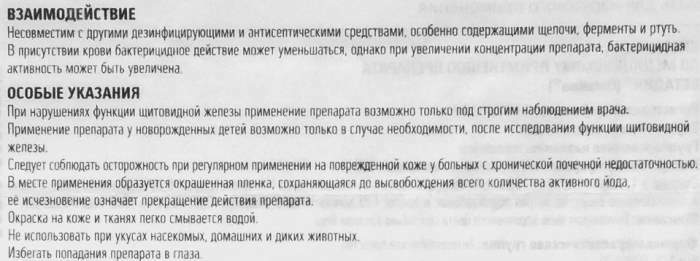Content
- Views
- Aorta
- Coronary
- Cerebral
- Lower limbs
- Upper limbs
- Renal arteries
- Penile artery atherosclerosis
- Stages and degrees
- Fat strips
- Fibrous plaques
- Complex violations
- Symptoms and Signs
- Causes
- Diagnostics
- Treatment methods
- Diet
- Drug treatment
- Operation
- Possible consequences and complications
- Video about atherosclerosis
Atherosclerosis is a systemic disease which initially affects the arteries containing cholesterol with esters. They create special plaques that are characteristic of this type of pathology. Below you can familiarize yourself with the types of the disease, its symptoms and signs, as well as methods of treatment.
Views
Atherosclerosis (symptoms and signs are given for informational purposes) has several varieties regarding the location of the pathology and which internal organ has impaired blood circulation.
Aorta
The disease affects the large arteries of the circulatory system. The aorta leaving the heart passes through the abdominal and thoracic cavities and branches into small vessels that communicate with the limbs, kidneys, lungs, digestive organs and the brain.
If atheromatous plaques form in one of the areas of the aorta, this can provoke serious consequences.
Coronary
It is considered a chronic pathology that forms lipid plaques in the lumen of the heart arteries. The latter interfere with normal blood flow, resulting in tissue ischemia.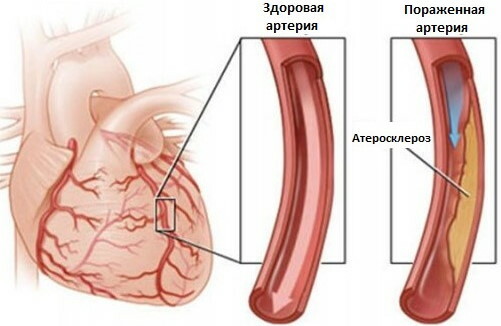
Coronary atherosclerosis is divided into 2 types:
- non-senosing, in which the lumen of the arteries narrows by less than 50%;
- stenosing, in which the narrowing of the lumen of the arteries reaches more than 50%.
As a result, myocardial infarction can occur, as well as ischemic heart disease.
Cerebral
Plaques form in the blood vessels of the brain, causing a stroke. In this case, the carotid arteries with a brachycephalic trunk may be affected. Although the artery can be narrowed by 50%, this type of disease can be asymptomatic.
Lower limbs
It manifests itself in those areas where large vessels branch out. Plaques often form in the popliteal and superficial femoral arteries. If you do not consult a specialist in time, one of the vessels may completely block. As a result, ischemic gangrene may occur, in which limb amputation may be required.
Upper limbs
Symptoms are very rare. Failure of lipid metabolism and plaque deposition are presented as a diffuse process that affects all arteries. The disease affects the state of the brain and heart. Blood flow in the hands can sometimes be impaired.
Renal arteries
The cause of the formation of vasorenal hypertension is the appearance of a plaque in the orifice of the renal artery.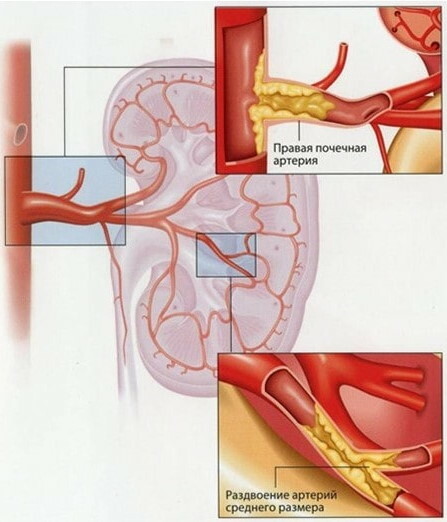 As a result, vascular thrombosis or damage to 2 kidneys may occur, which is considered a malignant tumor. To prevent the occurrence of a problem, it is necessary to undergo diagnostics in time.
As a result, vascular thrombosis or damage to 2 kidneys may occur, which is considered a malignant tumor. To prevent the occurrence of a problem, it is necessary to undergo diagnostics in time.
Penile artery atherosclerosis
Erectile dysfunction is considered the main symptom of the manifestation of pathology. However, with such a disease, it is recommended to perform a complete diagnosis for the presence of cardiovascular pathologies.
Stages and degrees
The course of the pathology is characterized by 3 stages of development, which have serious consequences.
Fat strips
After birth, small yellowish lipid spots form on the vascular walls. In the future, they will increase in size and combine with each other. Macrophages destroy them and become foam cells. Subsequently, fatty strips are formed from the foam cells and smooth muscle cells of the vessel walls.
However, at this stage of development, the pathological process may not progress, and fibrous plaques do not form.
Fibrous plaques
If fatty strips appear in the areas, connective tissue proliferation occurs. Fibrous plaques are formed from the latter and fat cells. Initially, they have a soft structure, which allows them to dissolve if medical intervention is carried out in time. Otherwise, calcium salts will begin to accumulate in them, and they will become solid.
Complex violations
Deformation of fibrous plaques occurs, as a result, cracks, ulcers or ruptures appear on them. This stage can be triggered by the accumulation of cholesterol or the activity of macrophages.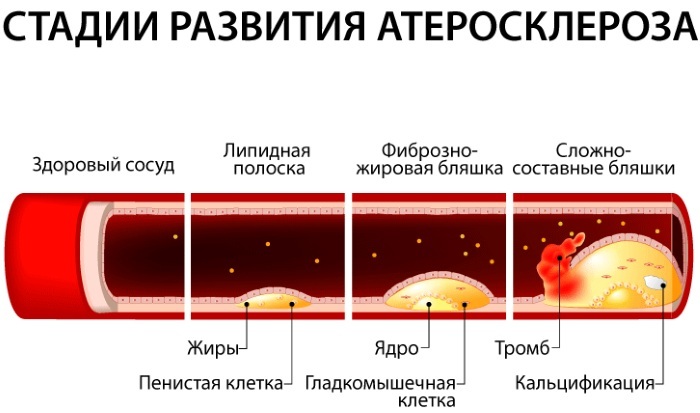
Platelets begin to adhere to deformed plaques, which provokes complete or partial blockage of the vessel.
Symptoms and Signs
Atherosclerosis (symptoms and signs at the initial stages of pathology may not appear) at an early stage it is permissible to detect only instrumental diagnostics, since a person may not feel that plaques have formed on the arterial walls until they begin to interfere normal blood flow.
Atherosclerotic deformity of the arteries can affect people aged 30 and older. However, at a more mature age, the factor of disease formation increases. Moreover, atherosclerosis is much more common in men than in women.
Symptoms and signs of pathology will depend on the affected arteries:
| Affected arteries | How does the disease manifest |
| Atherosclerosis of the aorta | The aorta is the main vessel of the arterial system. When it is affected, blood pressure will always be high. The main symptom is an increase in the first, large numerical indicator during pressure measurement. |
| Atherosclerosis of the upper limb arteries | Weakness in 2 or 1 arm may be felt. |
| Renal artery atherosclerosis | High blood pressure is considered a symptom of pathology. |
| Atherosclerosis of the cardiac vessels | It is a factor in the onset of ischemic heart disease. The form of the latter is angina pectoris, which is manifested by pressing pain behind the sternum, shortness of breath, high sweating and weakness. Atherosclerosis can provoke heart failure, heart disease or myocardial infarction. |
| Atherosclerosis of cerebral vessels | Sleep is disturbed, tinnitus, dizziness appear, concentration of attention decreases, and memory also deteriorates. If the vessel is completely blocked, an ischemic stroke can occur, in which part of the brain tissue dies. |
| Atherosclerosis of the vessels of the lower extremities | The main symptom of the onset of pathology is intermittent claudication, manifested by painful sensations in the calf muscles, which make them stop while walking. After stopping, the pain disappears. In the future, pain in the calf muscles can also manifest itself at rest, while trophic ulcers are formed. |
 The pathology is systemic, therefore, if deformed arteries are detected in one area, atherosclerosis can affect other vessels.
The pathology is systemic, therefore, if deformed arteries are detected in one area, atherosclerosis can affect other vessels.
Causes
Atherosclerosis (symptoms and signs will depend on age, lifestyle and the presence of other diseases) does not have an exact cause. When the arterial walls are deformed, lipids begin to be deposited in this area. As a result, atherosclerotic plaques are formed. However, deformation factors can be different.
There are several reasons that can increase the risk of atherosclerosis:
- Age. In adulthood, the vessels begin to wear out, clog up and lose elasticity. In this regard, people over 40-50 years old suffer from this pathology.
- Hypertensive disease. If high blood pressure is chronic, it provokes the development of pathological changes in the vessels.
- Climax. During menopause, the production of estrogen decreases in a woman's body. In this regard, a woman over 55 years old can get sick with this pathology.
- Smoking. It provokes high blood pressure with intoxication of the body and vasoconstriction. As a result, the activity of the vessels is disrupted.
- Excess body weight with minimal physical activity. Obesity practically does not affect the process of pathology formation. However, overweight people who adhere to a sedentary lifestyle often have high blood pressure, as well as an excessive amount of cholesterol. These factors provoke the development of the disease.
- Heredity. Genetic predisposition can affect the immune activity of the body and the failure of lipid metabolism. Heredity increases the risk of developing the disease up to age 50. In the future, it does not matter, since other factors provoke the pathology.
-
Improper diet. To avoid the appearance of disease, the diet must be balanced. Therefore, it is recommended to include a variety of ingredients in the menu, especially fresh and healthy products.
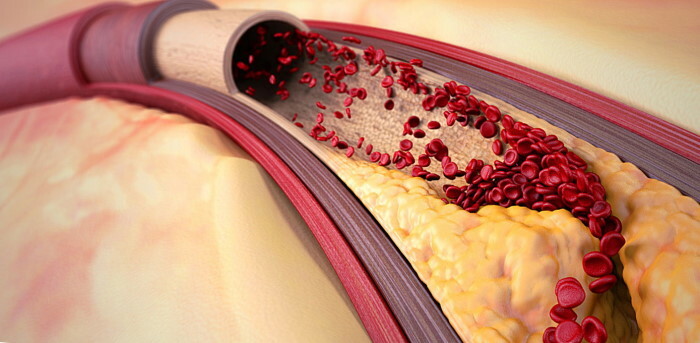
Atherosclerosis - Floor. Men under the age of 50 suffer from this pathology more often than women of a similar age. This is due to the fact that female sex hormones have a beneficial effect on lipid metabolism and on the metabolic process in the vascular walls. As a result, the risk of atherosclerosis formation is prevented.
- Diabetes. The metabolism of lipids and carbohydrates is closely interrelated. In this regard, if one is violated, another exchange may be affected.
- Stressful states. In stressful situations, adrenaline is formed in the body, which sharply increases blood pressure and constricts blood vessels. Stressful conditions can be strong nervous shocks, as well as everyday insignificant experiences.
- Excessive consumption of alcoholic beverages. With the constant intake of a large volume of alcohol, the factor of atherosclerosis formation increases. Under the influence of alcoholic beverages, initially expansion occurs, after vasoconstriction. Such fluctuations have a detrimental effect on the health of the cardiovascular system. Despite the fact that alcohol is able to break down some of the plaque, the dissolved fats will not be excreted from the body, since they remain in the internal organs. As a result, there is a failure in their activities. If you drink a small dose of alcohol every day, this will provoke the risk of many pathologies.
If the listed risk factors are present, a person may not get atherosclerosis, because he does not manifest itself in all people who have diabetes mellitus, high blood pressure, or the elderly age. However, for prevention purposes, it is advisable to try to reduce the number of risk factors.
Diagnostics
Atherosclerosis (symptoms and signs of a specific type of disease can be diagnosed with tests and ultrasound) can be examined at any medical center. The diagnosis will be based on the results of the instrumental diagnostic method and analyzes. A consultation with an examination is able to determine the causes of the pathology. Consultation with other doctors can tell you which organs have been affected.
To identify the disease, you need the following:
- Blood chemistry. For the results to be accurate, you need to stop eating fatty foods in 3 days, completely refuse food in 10 hours and not consume a lot of liquid. In 30 min. you can not smoke and worry. The cost of the analysis is approximately 2,150 rubles.
- Ultrasound of blood vessels and heart. Shows the symptoms of heart valve disease, aorta. Additionally, the arterial vessels of the lower extremities are examined. Price from 300 rubles.
- Electrocardiography. Shows heart rhythm failure and organ electrical conduction. The cost is about 37 rubles.
-
Angiography. To detect plaque, an X-ray diagnosis is performed using a contrast agent. Price - from 830 rubles. and higher.
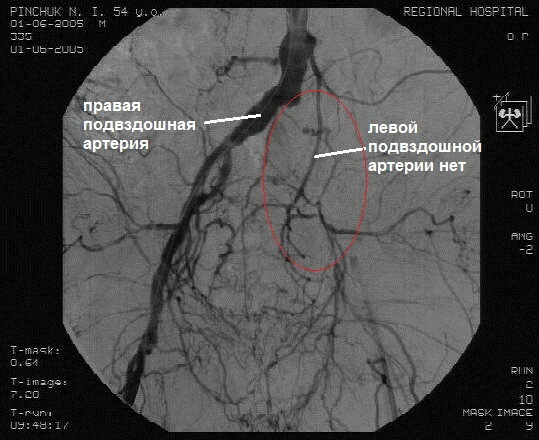
- Coronary angiography. Required when performing an operation on the cardiac vessels. The cost is about 3,000 rubles.
- Spiral computed tomography with contrast. Helps to detect pathological changes in the arteries of the brain and parenchymal organs. Price from 1 450 RUR
Additionally, a specialist may prescribe a general urine and blood test, as well as an ophthalmologist's consultation.
Treatment methods
Symptoms of atherosclerosis can be treated with several methods. However, at the same time, it is necessary to separate those procedures that are aimed at preventing signs of the disease and stopping its pace. development, as well as those activities that are aimed at treating pathologies associated with atherosclerotic deformation of the arteries.
Diet
It is recommended to change the lifestyle and adjust the diet. The patient should lose weight, give up alcohol and smoking, and perform moderate physical activity.
To reduce the level of cholesterol, it is recommended to abandon fried, spicy, spicy delicacies, semi-finished products, smoked with salty, fatty foods, as well as meat broths. At the same time, it is necessary to reduce the amount of salt intake.
Do not eat the following foods:
- cocoa;
- strong tea with coffee;
- store-bought nectar with juices;
- different sauces with mayonnaise;
- canned fish and meat;
- sugar;
- sweet drinks with gas;
- sweet dried fruits;
- sweets with pastries;
- offal;
- baked goods made from wheat flour.
It is necessary to adhere to a fractional five meals a day, the menu of which includes fermented milk products with fruits, vegetables (excluding potatoes), low-fat cottage cheese, low-fat fish and meat.
To clean the vessels, it is advisable to use oat and wheat bran, unrefined cereals, and coarse bread. It is recommended to eat about 200 g of fresh fruits and 300 g of vegetables per day.
To lower cholesterol, you need to eat crushed flax seeds. It is permissible to eat them just like that or add them directly to food. Together with dietary food, the patient should move regularly.
Drug treatment
Treatment with medication aims to achieve the following goals:
- fighting infections;
- elimination of excess cholesterol from the body;
- decrease in cholesterol production.
A specialist can prescribe the following drugs to patients:
- drugs with niacin, which normalize lipid levels;
- sequestrants that remove bile acids from the intestine, which are manifested with a decrease in cholesterol;
- statins, which reduce the production of cholesterol in the body;
- fibrates that reduce fat production;
- estrogens are suitable as hormone therapy during menopause in women.
The dosage with the course of treatment should be prescribed exclusively by the attending doctor.
Operation
If dietary food with medication does not help get rid of atherosclerosis, a specialist may prescribe the following surgical interventions:
-
Angioplasty. The operation requires an instrument with a catheter at one end and a small balloon at the other. The latter is introduced through a small puncture in the skin into the vascular lumen, inflating with compressed air. Due to this, the artery expands, and the plaque is evenly distributed along the wall. At the end, the balloon is deflated by removing it from the vessel.
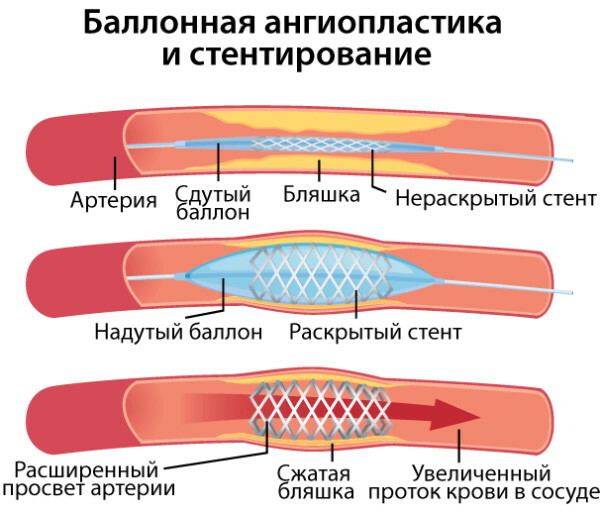
- Stenting. The operation requires a metal frame. Initially, the artery expands, after which a stent is inserted into it. Thanks to the latter, the lumen of the vessel expands, which normalizes blood flow.
- Bypass surgery. During the intervention, an artificial shunt is installed between the two points, which will bypass the narrowed area of the artery. As a result, the blood supply to the tissues is normalized. Basically, the operation is performed for the pathology of the lower extremities.
- Endarterectomy. The damaged artery is cut to remove plaque from its walls. As a result, the lumen expands and blood flow stabilizes. In the presence of a heart attack, angina pectoris, hypertension, congestive heart failure, malignant tumor or diabetes mellitus, such an operation is contraindicated.
Sometimes a specialist can combine several operational methods.
Possible consequences and complications
Atherosclerosis (symptoms and signs can worsen if not properly treated) of the lower extremities can be very dangerous if not treated promptly. As a result, gangrene, muscle atrophy or thromboembolism of the vessels of internal organs develops, if the plaque has detached.
If the coronary vessels were affected, complications may occur in the form of coronary sclerosis, myocardiosclerosis, focal dystrophy of the heart muscle, myocardial infarction.
When the mesenteric arteries are blocked, ischemic colitis or intestinal gangrene can occur. If there is a blockage of the renal arteries, secondary arterial hypertension may form.
Cerebral complications are manifested by ischemic or hemorrhagic stroke, atherosclerotic dementia, transient ischemic attacks.
Aortic aneurysm is especially dangerous for the patient's life. If it bursts, it can be fatal.
Symptoms and signs of the disease provoke a lack of nutrients and oxygen, as a result, the activity of internal organs gradually fails. In the presence of acute atherosclerosis, the blood flow is completely blocked, which causes serious consequences in the form of gangrene of the lower extremities, stroke, myocardial infarction and other dangerous complications.
Video about atherosclerosis
About atherosclerosis:



